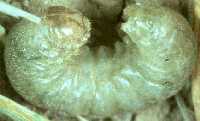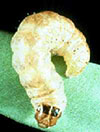by F.B. Peairs and J.L. Capinera * (9/14)
Quick Facts…
- Many species of caterpillars attack Colorado crops; the species involved will affect control decisions. Use the following descriptions to identify pests.
Fall Armyworm

Spodoptera frugiperda (Smith). This caterpillar is quite variable in color but has three yellowish-white thin lines going down the back and a darker, wider line and a broad yellowish line along the side. The setae arise from prominent black tubercles. The most distinguishing characteristic is the inverted white “Y” on the front of the head capsule. This pest attacks a wide variety of crops, particularly corn and sorghum. It migrates from the south into Colorado every year and is usually not a problem until the latter part of the growing season.
Variegated Cutworm

Peridroma saucia (Hubner). This climbing cutworm is best distinguished by a row of white to pale yellow dots that run along the midline of the back. There are at least four of these dots and may be as many as one per segment. The abdomen is mottled brown, sometimes with an orange stripe laterally. This insect attacks a wide variety of plants in Colorado, including alfalfa, corn, ornamentals and various vegetable crops. Three generations per year occur in Colorado, starting in late May, with the most important damage occuring in August.
Pale Western Cutworm

Agrotis orthogonia (Morrison). This subterranean cutworm has a greyish white, unmarked abdomen. It is similar in appearance to the glassy cutworm but has two distinct vertical brown bars on the front of the head capsule. This is an early season pest that attacks small grains, corn and alfalfa from very early spring through the end of June. It has but one generation per year.
Glassy Cutworm

Crymodes devastator (Brace). This subterranean cutworm has an unmarked, uncolored, somewhat translucent abdomen. It is similar in appearance to the pale western cutworm but lacks vertical brown bars on the front of the head. It is an early season pest of turf, corn, small grains and alfalfa. It has one generation per year that is completed by the end of June.

Western Bean Cutworm,
Loxagrotis albicosta (Smith). This small brown caterpillar is identified by faint diamond markings on the back. Mature larvae are brown to pale grey with dark brown bands behind the head. It prefers ear tips in corn and developing pods in beans. This insect overwinters in Colorado, although egg laying does not occur until late July.
Bronzed Cutworm

Nephelodes minians (Guenee). The abdomen of this subterranean cutworm is a dark bronzed-brown and has five distinct pale stripes running the entire length. It will attack turf, small grains, corn and other grasses early in the growing season. It has but one generation per year.
Dingy Cutworm

Feltia ducens (Walker). This subterranean cutworm will occasionally behave as a climbing cutworm. Its abdomen is a dull brown with a broad pale stripe down the back. When full grown it is somewhat smaller than the other cutworms with which it might be confused. It has only one generation per year, attacking such plants as alfalfa, corn, ornamentals and several vegetable crops.
Darksided Cutworm

Euxoa messoria (Harris). This climbing cutworm has a greyish brown abdomen with a narrow dark band on either side. It is an early-season pest that has but one generation per year. It attacks a variety of crops, including several ornamental tree species.
* F.B. Peairs, Colorado State University Extension entomologist and professor, and J.L. Capinera, former professor; bioagricultural sciences and pest management. 1/92. Revised 9/14.
Colorado State University, U.S. Department of Agriculture, and Colorado counties cooperating. CSU Extension programs are available to all without discrimination. No endorsement of products mentioned is intended nor is criticism implied of products not mentioned.
Go to top of this page.





